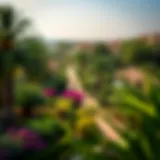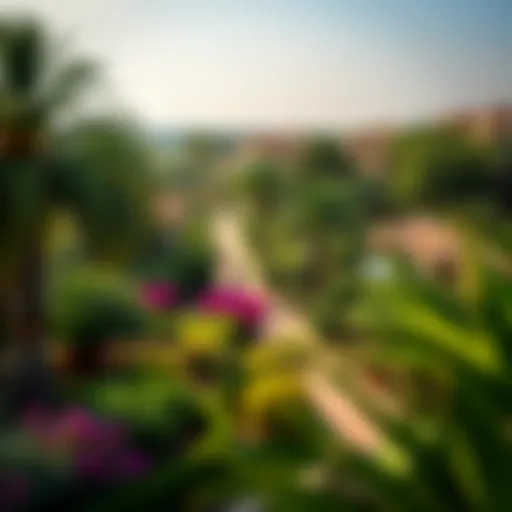Exploring Al Zarooni Tower: Architectural Significance
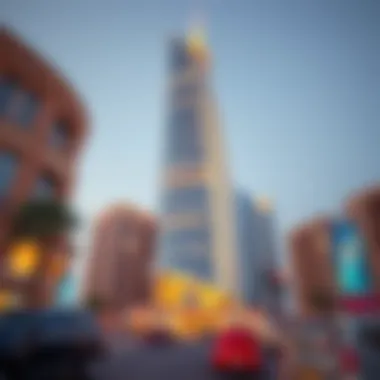
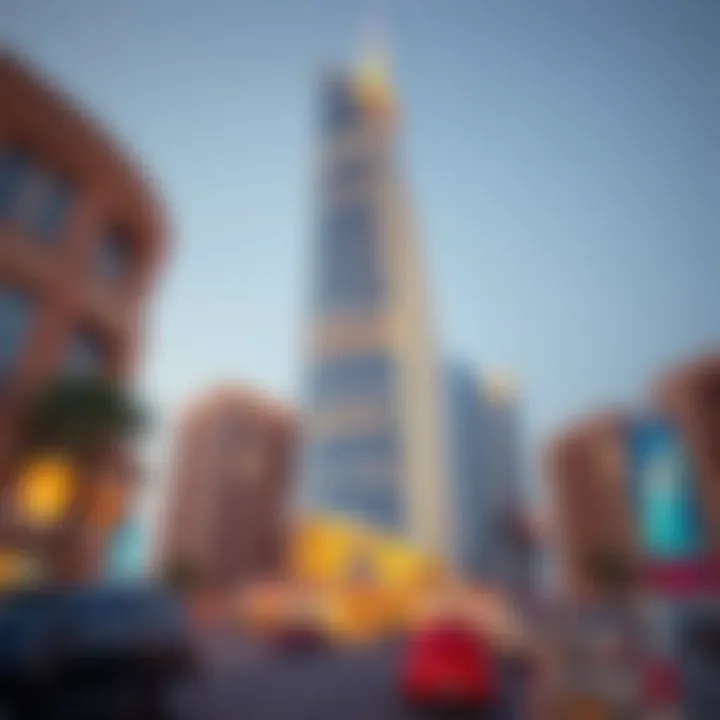
Intro
Al Zarooni Tower stands as a testament not only to architectural ingenuity but also to the evolving nature of urban life in Dubai. As an emblem of modern design and community interaction, the tower encapsulates a story that goes beyond mere bricks and mortar. It's nestled in an area that thrives with cultural vibrance, embodying both the charm of traditional Middle Eastern architecture and the boldness of contemporary styles. Through this comprehensive examination, we aim to shed light on the nuance behind the tower’s construction, its significance within the skyline, and its influence on the bustling environment that surrounds it.
Neighborhood Features
Landscaping Highlights
The landscaping surrounding Al Zarooni Tower is skillfully designed, combining aesthetic appeal with ecological functionality. The lush greenery interspersed with modern art installations creates an inviting atmosphere, encouraging both residents and visitors to engage with their surroundings. Palm trees and flowering shrubs align pathways, while serene water features add a soothing backdrop to the busy urban life.
Communities nearby are characterized not just by their structures but also by their environmental consciousness. The incorporation of public parks and walkable areas facilitates a choice of relaxation spots, drawing people in from the surrounding high-rise developments. This blend of nature and architecture creates a harmonious escape from the concrete landscape.
Architectural Styles
Al Zarooni Tower showcases a fusion of traditional Arabesque influences and cutting-edge modernity. The unique silhouette of the tower, with its flowing lines and intricate lattice work, reflects the intricate artistry of Islamic culture, while simultaneously embracing contemporary materials and innovative building techniques. It stands in stark contrast to the glass and steel giants of Dubai, yet it does so without losing its identity.
The careful balance of classical and modern styles prompts viewers to appreciate the cultural tapestry of Dubai's skyline. As you wander the streets around the tower, you'll notice how it commands attention, harmonizing with its surroundings yet standing out as a beacon of good design.
Community Life
Local Events and Activities
The area around Al Zarooni Tower is bustling with local events that foster a strong sense of community. Every month, the local council organizes art markets, cultural festivals, and food fairs, bringing people together to celebrate various aspects of life in Dubai. These gatherings not only spotlight local artisans and chefs but also promote unity among residents, highlighting the diversity that contributes to the richness of the community.
Many residents look forward to annual celebrations that align with national holidays. These occasions often involve outdoor activities like sports competitions, fairs, and concerts, ensuring there's never a dull moment for families and individuals alike.
Lifestyle Amenities
Life around Al Zarooni Tower is enriched with a plethora of lifestyle amenities designed to cater to varying needs. You will find an array of cafés, restaurants, and boutique shops right at your doorstep. From informal coffee spots to upscale dining experiences, there's something for everyone.
Moreover, health and fitness are prioritized in this community, thanks to the proximity of gyms and wellness centers. Many residents take full advantage of outdoor fitness courses offered in the parks, promoting an active and healthy lifestyle.
The overall vibe around Al Zarooni Tower resonates with a sense of community and well-being, making it not just a place to live, but a space to thrive together.
"Al Zarooni Tower is not just an architectural marvel; it's the lifeblood of a community filled with warmth and hope." - Local resident
Prelude to Al Zarooni Tower
Al Zarooni Tower stands not just as a building, but as a key piece of Dubai's evolving narrative. In a city known for its audacious architecture and inventive urban projects, understanding this tower offers insights into the architectural ambitions and social dynamics of the region. It serves as a prime example of how modern design can harmonize with the deeply rooted cultural context, making it vital for every homeowner, architect, visitor, and urban planner to take note.
The Significance of Al Zarooni Tower
This tower is far more than a mere high-rise; it embodies the spirit of Dubai's relentless forward momentum. As one gazes upon its structure, the blend of traditional elements with contemporary aesthetics becomes apparent. Each facet of its design tells a story not only about engineering techniques but also about the aspirations of a growing metropolis. Al Zarooni Tower stands as a testament to Dubai’s ambition to be at the forefront of architectural innovation while maintaining a connection to its past.
Community Influence
For the residents and businesses surrounding it, Al Zarooni Tower represents much more than a backdrop. It influences the lifestyle and community interactions in the area. The tower amalgamates residential spaces with commercial endeavors, thus enhancing the socioeconomic fabric of its vicinity. This duality plays an essential role in the daily lives of countless individuals passing through its halls or living nearby.
Considerations for Future Development
As urbanization continues to surge, the future planning around Al Zarooni Tower will likely reflect shifts in architectural trends and community needs. Stakeholders must remain vigilant and adaptive to the changes that come with urban growth. This includes considering sustainability and innovative designs that prioritize both aesthetics and functionality. After all, the tower is not just a snapshot of the present, but also a canvas for future urban planning.
Historical Context
Understanding the historical context of Al Zarooni Tower sets the stage for appreciating its architectural significance and cultural impact. This section delves into the origins and the various historical layers that contribute to the tower's identity. The importance of this context lies not only in how it showcases the evolution of architecture in Dubai but also in how it reflects the socio-economic patterns over the years, providing a backdrop against which modern developments unfold.
Origins of Al Zarooni Tower
Al Zarooni Tower was conceived during a transformative era for Dubai. This period was marked by rapid urbanization and economic growth that reshaped the region. The origins of the tower can be traced to a vision of establishing a prominent landmark that represents modern architecture while honoring local traditions.
Construction commenced in the early 2000s, tapping into advanced engineering techniques and materials that the world had to offer. The choice of materials for the structure was a significant factor that influenced its robustness and aesthetic appeal. Concrete and glass were predominant, allowing the building to reflect the sun and change color depending on the time of day.
Notably, the tower’s conceptualization involved a blend of both local enterprise and international expertise. This collaboration emphasizes Dubai's image as a global hub, paving the way for structures that blend functionality with artistic vision. The tower, upon completion, stood out not only for its height but also for the creative design and engineering challenges it overcame, making it a key player in the urban narrative of Dubai.
Significance in Local History
The significance of Al Zarooni Tower extends beyond its architectural merits. Its establishment marked a pivotal moment in Dubai’s history, an emblem of ambition and innovation that would define the city’s trajectory.
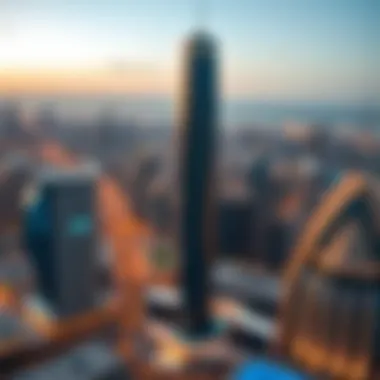
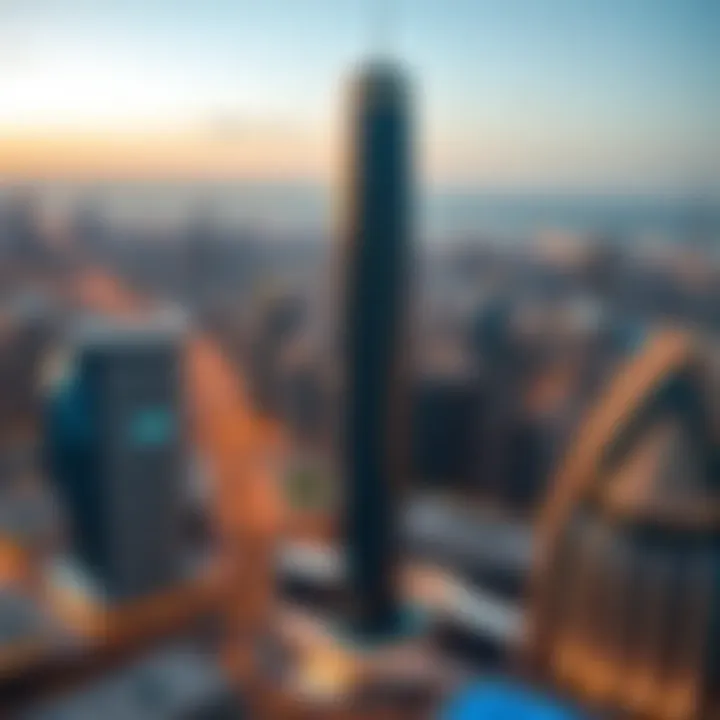
- Symbol of Progress: Al Zarooni Tower symbolizes a break from traditional design philosophies towards more avant-garde approaches in urban planning. It served as an inspiration for many subsequent projects in the region.
- Cultural Significance: The tower has become a cultural landmark and meeting point for residents and visitors alike. It stands as a testament to the community's evolution, embodying both historical reverence and forward-thinking aspirations.
- Economic Impact: Al Zarooni Tower's presence has stimulated local business activities in the surrounding area. The incorporation of commercial spaces within the tower itself attracted investors and entrepreneurs, creating a ripple effect that boosted the local economy.
In essence, the historical context surrounding Al Zarooni Tower offers invaluable insights into the growth and identity of Dubai as a vibrant metropolis. Understanding these elements enriches one’s appreciation for not just the tower itself, but for the broader architectural and sociocultural landscape of Dubai.
Architectural Design
The architectural design of Al Zarooni Tower is not merely a matter of aesthetic appeal; it plays a significant role in how the structure interacts with its environment and the ethos of modern Dubai. By blending functionality with an iconic silhouette, the design contributes to the cultural identity of the area. Furthermore, it raises discussions about urban aesthetics, the skyline's overall composition, and how such structures can harmonize with nature and surroundings. Al Zarooni Tower serves as both a landmark and a functional space, illustrating the dual role of contemporary architecture.
Design Features
Facade elements
The facade of Al Zarooni Tower showcases an array of materials and textures that aim to convey a sense of elegance and modernity. One of the key characteristics of these facade elements is the use of glass and steel, which facilitates natural light influx while minimizing energy consumption. This choice is particularly beneficial in Dubai's hot climate, as reflective surfaces help control internal temperatures, enhancing visitor comfort.
Moreover, the unique feature of the facade includes vertical fins that break the monotony of the glass surface and contribute to the structure's aerodynamic resilience against winds. However, while glass offers a sleek appearance, it requires regular maintenance to retain its shine and aesthetic appeal.
Structural innovations
In terms of structural innovations, Al Zarooni Tower incorporates high-strength concrete and advanced seismic technology, which not only ensures stability but supports the tower reaching impressive heights. A key characteristic of these innovations is the integration of a core system that centralizes all the essential structural components, allowing for an efficient load-bearing design.
One unique feature is the use of lightweight materials in conjunction with traditional building elements, easing construction burdens and streamlining the entire building process. On the downside, while these innovative materials and methods increase durability, they can also lead to higher initial costs and often require specialized knowledge for effective implementation.
Architectural Style
Influences
The architectural style of Al Zarooni Tower takes cues from both Islamic architecture and contemporary design principles. This blend creates a fresh, appealing appearance that resonates well with Dubai's cosmopolitan image. The influence of traditional Gulf design elements, such as arches and intricate geometric patterns, serves not only as homage to the local culture but also allows the building to blend with its historical context while standing out as a modern landmark.
One particularly notable aspect of this influence is the way it draws from nature—using flowing lines that mimic natural forms, offering an organic touch in an urban setting. Yet, the integration of these traditional motifs with modern lines may not appeal to purists who advocate for a purely contemporary or historic approach.
Comparisons with other structures
When compared to other iconic structures in Dubai, Al Zarooni Tower boasts a distinct identity. Its height and architectural complexity align it with other skyscrapers, yet it sets itself apart through its unique design language that maintains cultural coherence. One pivotal feature is its emphasis on verticality and how it harmonizes with nearby landmarks like the Burj Khalifa and Emirates Towers.
This style presents a dual advantage; it captures attention while fostering a sense of continuity among the other structures in the area. On the flip side, towering alongside such renowned architectural rivals raises expectations, putting additional pressure on future upkeep and innovation within the design.
Construction Details
The construction details of Al Zarooni Tower offer crucial insights into not only its functionality but also its place within Dubai's evolving urban fabric. Understanding these elements provides a comprehensive view of how the tower was conceived and realized, shedding light on the engineering marvel behind its towering presence. This section dives into the timeline of the project and the materials that bring it to life, laying the groundwork for appreciating its architectural significance.
Project Timeline
The timeline for constructing Al Zarooni Tower is anything but ordinary. The ambitious project kicked off with preliminary planning stages in 2013, driven by a desire to blend modernity with tradition. The groundbreaking ceremony took place later that year, marking the dawn of a new architectural landmark in Dubai. Completion followed in 2017, a notable achievement considering the complexities involved. The project answered to the demands of rapid urban growth while ensuring that each stage was well-planned and executed.
Key phases of the timeline include:
- 2013: Initial planning and design concepts finalized.
- Early 2014: Groundbreaking ceremony.
- 2015: Structural framework commenced, facing challenges typical of large-scale constructions.
- Late 2016: Significant advancements made in façade installation and interior layouts.
- 2017: Final inspections and official opening.
The timeline, filled with milestones, reflects the project’s commitment to blending efficiency with quality. Each major step was intricately planned to ensure that the tower would not only rise above others but stand the test of time as well.
Materials Used
The materials selected for Al Zarooni Tower were chosen with meticulous care, reflecting the desire for sustainability and durability. This important decision is more than a matter of aesthetics; it forms the backbone of the structure's integrity and longevity.
- Concrete: The primary material utilized was reinforced concrete, chosen for its resilience and ability to withstand the elements. The use of high-performance concrete allows the tower to resist wear over time, critical for maintaining its imposing stature.
- Glass: Expansive glass windows formed a significant portion of the design. They not only enhance the visual aesthetic by allowing natural light to flood in but also engage with the surrounding environment, creating a harmonious atmosphere. Double-glazing technology was employed to ensure energy efficiency, reflecting a modern approach to sustainable architecture.
- Steel Reinforcements: To add additional strength, steel reinforcements were integrated throughout the structure. These materials help manage the loads and stresses typical in a skyscraper, providing reassurance of safety and stability against seismic activities common in the region.
- Natural Stone: Selective use of natural stone in the façade not only enhances visual appeal but also aligns with the cultural heritage of the area, making it an integral decorative element.
The blend of these materials indicates a thoughtful approach, balancing modern engineering with traditional elements, creating a building that resonates with Dubai’s cityscape both aesthetically and structurally.
Impact on Dubai's Skyline
The Al Zarooni Tower plays a pivotal role in shaping the skyline of Dubai, a city known for its breathtaking architecture and daring innovations. This tower is not just a building; it stands as a symbol of the dynamic growth and ambition that characterize this vibrant metropolis. The impact of the Al Zarooni Tower on the skyline can be observed through various lenses, including its visual dominance, cultural significance, and its overall contribution to the urban landscape. By examining these elements, one can appreciate not only the aesthetics but also the deeper meanings embedded within this architectural marvel.
Visual Dominance
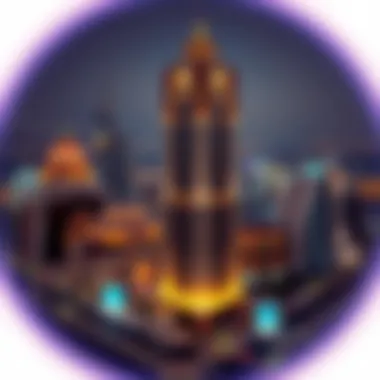

Significance to the skyline
The Al Zarooni Tower rises majestically among its peers, contributing a unique silhouette to the Dubai skyline. The visual dominance of this structure cannot be overstated. Its design, coupled with its strategic position, allows it to capture the eye of both locals and visitors alike. A key characteristic that sets it apart is its height, which, when observed from a distance, commands attention and admiration. This prominence is vital, as it reinforces the message that Dubai is a city where aspirations reach for the sky—literally.
Additionally, the tower's intricate facade design and innovative lighting features enhance its visibility during day and night, transforming the way it interacts with its environment. The unique feature of Al Zarooni Tower is its reflective glass exterior, which not only contributes to its sleek appearance but also plays a functional role, reflecting the surrounding buildings and skies, further integrating it into the landscape of the city.
That said, the visual impact can also spark discussions around urban design and the balance of aesthetics versus functionality. Some might argue that the sheer scale of such structures can overshadow smaller developments, potentially creating a skyline of disparities rather than a cohesive urban fabric.
Comparative height and design
When assessing comparative height and design, the Al Zarooni Tower proudly stands among the tallest structures within Dubai. Its architectural prowess is evident when placed alongside neighboring skyscrapers. The height serves not merely as a statistic but as a statement of ambition and progress. The tower's design incorporates modernist principles with elements that echo traditional architecture, allowing it to be both cutting-edge and reflective of local culture.
In practical terms, its design ensures that it meets the demands of urban living while providing ample space for commercial and residential purposes. This dual functionality is beneficial, offering a microcosm of the living environment that Dubai embodies—balancing work and leisure within its towering expanse.
Nevertheless, challenges also emerge, particularly regarding building regulations and urban planning standards. The height of the tower creates shadows and limits on sunlight for nearby structures, prompting a need for thoughtful consideration in future developments to ensure that they do not infringe upon the comfort and livability of the surrounding community.
Cultural Symbolism
The Al Zarooni Tower serves as a cultural landmark, encapsulating the spirit of a city that is constantly evolving yet deeply rooted in its heritage. Each feature of the tower can be viewed as a reflection of the broader cultural narratives that resonate within Dubai. Its design often sparks dialogues about the fusion of contemporary architecture with historical influences, creating a statement that is both relevant and purposeful in today’s fast-paced environment.
In essence, the significance of Al Zarooni Tower is not merely in its height or design but in what it represents for Dubai's future—a blend of tradition, innovation, and community integration.
Surrounding Infrastructure
Al Zarooni Tower stands not just as an architectural marvel but as a pivotal part of the urban fabric of Dubai. Understanding its surroundings is fundamental to grasping its full impact, especially regarding how infrastructure supports and enhances its role within the city. The surrounding infrastructure contributes significantly to the tower's functionality and accessibility, ultimately affecting the quality of life for those who live and work nearby.
Accessibility
Accessibility is a key feature concerning the surrounding infrastructure of Al Zarooni Tower. A well-designed urban space ensures that both residents and visitors can reach destinations effortlessly, thus promoting a vibrant community atmosphere. The flow of people through the area is a clear indicator of the tower’s integration into the broader environment.
Transport links
When discussing transport links, one must recognize the extensive network of roadways and public transport options that connect Al Zarooni Tower to various parts of Dubai. Nearest metro stations offer rapid transit choices, allowing commuters easy access to major business hubs and recreational areas. This accessibility is a significant characteristic that makes Al Zarooni Tower an attractive choice for living and business operations.
The unique feature of these transport links lies in their efficiency; they reduce travel time and promote sustainability by decreasing reliance on personal vehicles. Advantages include a decreased carbon footprint and enhanced local engagement. However, during peak hours, transport systems can become congested, posing challenges that need continuous management.
Proximity to key districts
Proximity to key districts is another aspect that adds to the allure of Al Zarooni Tower. Situated near popular neighborhoods, shopping areas, and cultural landmarks, the tower benefits immensely from its strategic location. The allure of being just a stone's throw away from vibrant districts enhances both residential and commercial opportunities.
Its close tie to various key districts not only supports a bustling economy but also fosters community interactions, which is essential for modern urban living. A unique feature of this proximity is the tower’s collaboration with nearby businesses, promoting synergistic relationships that can further enhance local development. Despite the many benefits that arise from its location, one must consider the downside of rising property prices, which can make it a tough choice for potential residents and business owners.
"The future of urban spaces like Al Zarooni Tower hinges not only on grand designs but on the ability to weave a functional network of accessibility, ensuring thriving lifestyles for all who reside and work in their shadows."
Understanding the surrounding infrastructure, specifically in terms of accessibility and its connection to key districts, paints a fuller picture of Al Zarooni Tower's place in Dubai. This melding of urban planning and architectural excellence creates not just buildings, but communities.
Community and Lifestyle Integration
The Al Zarooni Tower stands proud not merely as an architectural delight but also as a pivotal part of the community's pulse. Its influence stretches beyond towering heights, weaving seamlessly into the lifestyle fabric of the area. This integration plays a critical role in shaping how residents engage with their surroundings, making it a focal point for both social and commercial activities.
Residential and Commercial Use
The integration of residential and commercial spaces within and around Al Zarooni Tower reflects a thoughtful approach to urban living. This multifaceted utilization brings various benefits to the community, enhancing the overall experience of those who dwell and work nearby.
First and foremost, the presence of residential units in close proximity to commercial establishments promotes a convenient lifestyle. Residents can easily access shops, dining options, and services, reducing the need for long commutes and enhancing the quality of life. In a fast-paced city like Dubai, such accessibility becomes invaluable.
Moreover, the architectural design of Al Zarooni Tower facilitates this blend. The lower floors, often designated for shopping and commercial activities, create a vibrant atmosphere. They invite foot traffic, keeping the area animated throughout the day and allowing a natural interaction between locals and visitors.
Here are some key aspects to consider:
- Economic Boost: The presence of retail and leisure facilities within the tower not only provides convenience but also fosters economic growth by attracting customers from various demographics.
- Social Hubs: Cafés, restaurants, and boutiques housed in the commercial sections often become meeting points for friends and family, promoting community bonding.
- Attracting Talent: With residential accommodations just an elevator ride away from professional environments, the tower draws a diverse talent pool, contributing to a dynamic workforce within Dubai.
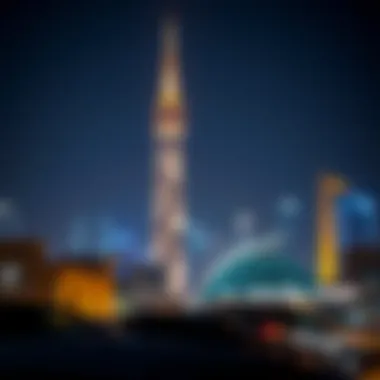
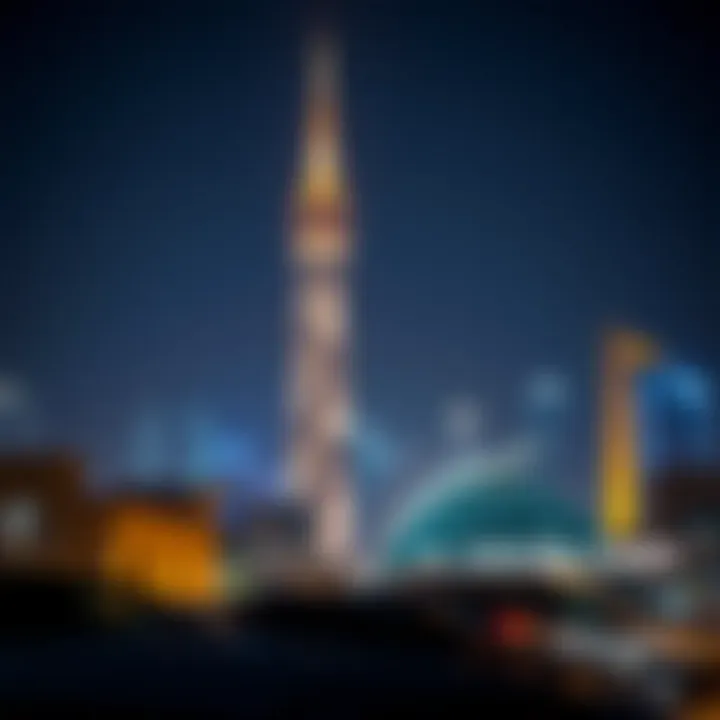
"A well-integrated community thrives on the connections between living spaces and commercial needs, creating an ecosystem where both can flourish."
As urban planners and architects look to the future, the lessons learned from the Al Zarooni Tower's community integration will shape modern developments. Understanding how lifestyle integration can bring quality to urban living is a critical aspect for homeowners, visitors, and local businesses. By fostering a harmonic relationship between residential and commercial use, the tower not only influences the skyline but also enhances the day-to-day interactions of its inhabitants.
Environmental Considerations
When discussing architectural marvels like Al Zarooni Tower, it is essential to highlight the environmental considerations that influence not only the design of the structure but also its ongoing impact on the surrounding area and the wider context of urban development. As global awareness of climate change and sustainability grows, incorporating these elements into architectural practices has become more significant than ever, making it a central theme in contemporary discussions about urban landscapes.
The construction and operation of skyscrapers often require substantial resources and energy. Thus, focusing on environmental considerations involves examining the sustainability measures employed during and after the construction process. Achieving a balance between aesthetic appeal and ecological responsibility is crucial, especially in a fast-developing city like Dubai, where the skyline evolves rapidly.
An architecture that embraces sustainability not only helps in reducing the ecological footprint but also contributes significantly to the energy efficiency of buildings. For Al Zarooni Tower, this could involve the integration of innovative technologies and materials that yield minimal environmental harm. Energy-efficient designs can lead to decreased operational costs and increased value over time, providing substantial benefits for residents and business owners alike.
"The energy-efficient design not only ensures a healthy living environment but adds long-term economic benefits for the community."
Sustainability Measures
In the context of Al Zarooni Tower, sustainability measures can encompass various elements that create a more holistic approach to environmental responsibilities. Some notable initiatives may include:
- Energy Management Systems: The implementation of smart building technologies can optimize energy use, often utilizing sensors and automated systems that adjust lighting, heating, and cooling based on real-time conditions.
- Water Conservation Techniques: Projects incorporating rainwater harvesting systems and greywater recycling can greatly reduce water consumption. These methods can capture and repurpose rainwater for non-potable uses within the tower, contributing to a sustainable water supply.
- Green Roofs and Vertical Gardens: By incorporating green spaces, the building not only enhances aesthetic value but also regulates temperature. Plants can improve air quality and provide insulation, thus reducing the need for extensive heating and cooling.
- Renewable Energy Sources: Utilizing solar panels, wind turbines, or geothermal energy systems can significantly diminish reliance on conventional energy sources while promoting a cleaner and more efficient energy model.
- Sustainable Materials: Choosing materials that are recycled or sourced from eco-friendly processes can reduce the environmental footprint of construction, extending throughout the building’s life cycle.
Implementing these sustainability measures not only aligns Al Zarooni Tower with a growing global trend but also sets a precedent for future developments in Dubai. As the demand for sustainable living environments increases, the integration of green practices within impressive architectural feats will be a guiding feature for modern urban landscapes.
Future Developments
As Al Zarooni Tower continues to stand as a hallmark of architectural brilliance in Dubai, the conversation about its future developments becomes ever-more critical. This section delves into the implications of urban planning, growth potential, and how these developments can reshape not just the tower itself, but also its interactions with the surrounding environment. Future developments build on the foundation laid by the tower and offer opportunities for enhancing community integration, improving infrastructure, and embracing sustainability.
Urban Planning Insights
The urban landscape of Dubai is continually evolving, and at the forefront is the potential for vertical expansion. This approach allows for the maximization of limited land space while accommodating the growing population and economic activities that characterize the emirate. The following sections elaborate on the potential benefits of further development surrounding Al Zarooni Tower.
Potential for vertical expansion
Vertical expansion refers to the upward growth of existing structures. In the case of Al Zarooni Tower, this could mean additional floors that serve varied purposes like residential or commercial spaces. The key characteristic of this approach is its capacity to maximize land use in densely populated areas.
One notable feature of potential vertical growth is its ability to provide skyline-defining structures that are not only impactful in aesthetic terms but also functional. It can cater to the increasing demands for space in urban environments. The advantages of this strategy lie in:
- Efficient land utilization: Building upwards helps in minimizing the footprint of developments.
- Boosting economic factors: More floors can translate to increased revenue potential from both residential and commercial tenants.
However, vertical expansion is not without challenges. There is often a balancing act required between maintaining the original design integrity of Al Zarooni Tower while introducing new elements that can complement its stature. Additionally, zoning regulations must be considered, which could limit expansion options.
Integration with future projects
Looking ahead, integrating Al Zarooni Tower with upcoming developments is another crucial aspect of urban planning. This could mean creating synergistic relationships between the tower and surrounding infrastructure, such as new transport links and public spaces designed to enhance the lifestyle of residents and visitors alike.
The value of integration can’t be overstated. It brings about:
- Improved accessibility: Connecting via paths, transit systems, and public amenities can enrich community relationships.
- Cohesive design: Future projects can be conceptualized to maintain a historic design language that reflects the cultural identity of the area while also showcasing innovation.
A unique feature of this integration is the potential for mixed-use developments. This could mean combining residential housing, offices, and commercial spaces into a unified vision that enhances the vibrancy of the area.
The advantages of this strategy encompass:
- Community enrichment: By fostering interaction among different user groups, the developments can create a more lively atmosphere.
- Cultural continuity: Respecting the origins and significance of Al Zarooni Tower within the broader context of new developments.
Ultimately, engaging with these emerging developments will play a paramount role in shaping how Al Zarooni Tower is perceived, utilized, and becomes entwined in the evolving story of Dubai’s ever-changing skyline.
"Modernizing the past while boldly looking to the future—this is the very essence of architecture's evolution."
Further information on urban development can be accessed at Wikipedia and Britannica.
Epilogue
The conclusion serves as a crucial element not only in this article but in understanding the broader implications of Al Zarooni Tower within the urban framework of Dubai. It encapsulates key takeaways that frame the tower not just as a structure, but as a landmark of civic pride and architectural ingenuity.
In wrapping up the various aspects discussed throughout the article, we can appreciate the tower’s distinctive architectural design, which highlights the seamless blend of modern aesthetics with cultural sensibilities. The tower does not merely alter the skyline; it also enriches the surrounding community, acting as a focal point that draws in visitors and bolsters local business engagements. The synergy created between the tower and its environment exemplifies the importance of thoughtful urban design.
A significant benefit of understanding the role of Al Zarooni Tower is its potential to serve as a model for future developments in Dubai and similar urban settings. It prompts us to think about sustainability and innovative designs in upcoming projects, ensuring these new structures honor their surroundings while fostering community engagement. Additionally, recognizing future plans and adaptations of the tower further illuminates its adaptability and relevance as city dynamics evolve.
In summary, Al Zarooni Tower is more than just an architectural statement; it embodies a narrative of progress, community, and cultural evolution. As stakeholders like homeowners, visitors, and city planners consider its lessons, they can contribute to sustaining its legacy while paving the way for future innovations.














